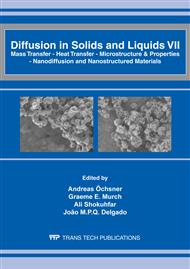p.405
p.410
p.416
p.422
p.428
p.434
p.440
p.446
p.452
Experimental Evaluation and Simulation of Al/Si Diffusion in Hot Dipped Fe-Si Steels
Abstract:
Hot dipping is a coating technique used in industry for galvanizing machine elements and steel profiles for construction or automotive applications. However, an alternative use of this process might be to improve specific properties. For instance, in order to improve the magnetic properties of electrical steels, it may be desirable to increase the Si and/or Al content. A possible and alternative route to realize this is by the application of an Al-Si-rich coating on the steel substrate using a hot dipping process, followed by a diffusion annealing treatment in order to distribute the Al/Si more evenly in the steel. The obtained distribution depends on the annealing parameters and can be both beneficial and detrimental for the magnetic properties. In the present work, Fe-Si substrates were hot dipped in different Al-Si baths. Subsequently, the samples were annealed at 1100°C during 20 minutes and concentration profiles were measured with scanning electron microscope energy dispersive spectroscopy line scans. The experimental results were analyzed using a specifically designed simulation model in order to determine the Al and Si diffusion coefficients. This model uses an inverse algorithm to determine interdiffusion coefficients that arise in a macro ternary diffusion system.
Info:
Periodical:
Pages:
428-433
Citation:
Online since:
April 2012
Price:
Сopyright:
© 2012 Trans Tech Publications Ltd. All Rights Reserved
Share:
Citation:


